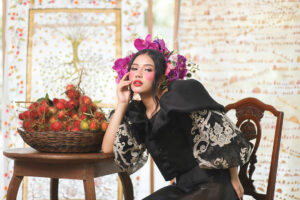NOW in her 70s, Patis Tesoro, the grande dame of Filipino fashion, doesn’t seem like she will be running out of steam anytime soon. At a benefit show called Filipiniana is Forever (also the title of Ms. Tesoro’s book, released earlier this year) for the Zonta Club of Alabang on Nov. 4, the designer showed an 86-piece collection (she counted them herself; press releases from the organizers counted 100). None of them were from the archives of the woman who helped revive the dying piña1 industry back in the 1990s. “All fresh,” she told BusinessWorld after the show.
One hundred percent of the ticket sales for the evening — the show was held at the Grand Hyatt Manila’s ballroom — was earmarked towards the Zonta Club of Alabang’s advocacy programs, centered on women’s health, education, livelihood, and development. It was also a selling show, with about 30% of the sales from Ms. Tesoro’s clothes going towards the Zonta Club.
Men clad in (just) malongs2, with different checked patterns and embroidered with gold outlines, opened the show. Women wore pink pants and embroidered baros (a loose top that serves as the upper garment of a traditional Filipiniana dress), then a silver brocade top with black figures over a dress. Ms. Tesoro’s signatures were seen all throughout: native textiles (sheer piña with heavy, opaque cotton patadyong3; among others), then fanciful embroidery in all the colors of a garden, outlined in gold. Ms. Tesoro, aside from being one of the most famous fashion designers of her generation, is also an accomplished gardener.
It was not all just traje de mestizas, ternos, and baro’t sayas4— though hers are lovely: we saw some of her work painted all over with pink roses, executed with contrasting blackwork embroidery. Another one had a green lattice pattern woven into the fabric, while dragons appeared on a magnificent traje de mestiza, scattering green and gold all over it. The finale dress was a traje de mestiza with white-worked sleeves woven with delicate red flowers paired with a trailing black skirt. Other than her usual — nay, classic — repertoire of Filipiniana, we saw coats in a reptilian green Chinese silk, barongs5 embroidered in gold, richly embroidered robe de styles, and tunics and shifts heavily embroidered and appliquéd all over.
Asked where she got the energy to mount such a show, she said with laughter, “I’m not dead yet.” On a serious note, she says she gets her energy from a mission: “To make sure that our culture goes forward and does not die.”
She’s not done yet: among her upcoming plans and projects are an artists’ enclave she hopes to put up with painter Romulo Galicano (whom she fondly calls Mulong), and a Filipino-style old folks’ home.
“I want to also be involved in a piña museum — which we do not have,” she said.
As we’ve mentioned, it’s a busy year for her, with a documentary accompanying the release of the Filipiniana is Forever book, a partnership with younger fashion designer Jor-el Espina, a retrospective in the Iloilo Museum of Modern Art, and now a brand-new collection. Rosy-cheeked and much younger-looking that evening, she told BusinessWorld, “I think people think I’m old and I’m going to die. Maybe that’s why they want all of these to happen.”
With a laugh good enough for a fairytale witch however, she said, “But I’ll surprise them and live for another 50 years!” — Joseph L. Garcia
1Piña is a translucent fabric derived from pineapples from which much traditional clothing is made.
2Malongs are traditional tube skirts from Mindanao.
3Patadyong is a tube skirt from the Visayas, usually made in a checkered cotton fabric.
4Traje de mestizas, ternos, and baro’t sayas are three kinds of traditional formal women’s wear. The first, also called the Maria Clara, is composed of a full skirt, and a piña loose-sleeved top and kerchief. The terno is a formal long gown with butterfly sleeves. The baro’t saya — literally blouse and skirt — is made of a loose blouse, sometimes of piña, a skirt that can fall from the knee to the ground, a tapis or overskirt, and an alampay or small scarf draped over a shoulder.
5Barong or barong Tagalog, is a formal men’s shirt made of embroidered piña.

